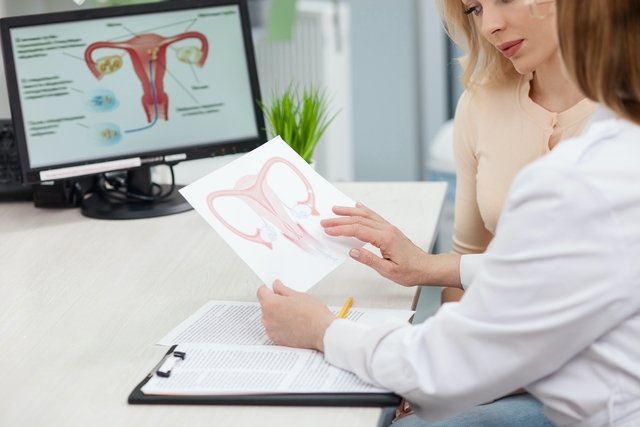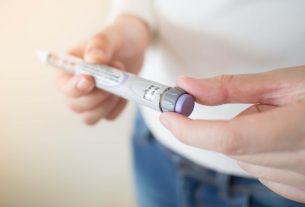Endometriosis is the abnormal growth of endometrial cells outside the uterus, causing symptoms such as intense menstrual cramps, heavy menstruation, frequent urge or urgency to urinate, or constipation with very strong cramps, for example.
Endometriosis most commonly affects the ovaries or fallopian tube, but it can also occur inside or on the surface of the bladder, or intestines, for example, and its cause is not completely known, however, it is known that it depends on estrogen. to grow.
Treatment for endometriosis must be carried out in accordance with the guidance of the gynecologist and involves the use of medications that help to alleviate and control symptoms, and surgery may also be necessary, in more serious cases.

Endometriosis symptoms
The main symptoms of endometriosis are:
- Intense cramping before or during menstruation;
- Pain during intimate contact;
- Heavy menstruation;
- Bleeding outside the menstrual period;
- Pain when urinating;
- Constipation or diarrhea;
- Pain when evacuating;
- Swelling in the belly;
- Excessive tiredness.
Furthermore, endometriosis can make pregnancy difficult and is often diagnosed during tests to identify the cause of female infertility. See the main tests to identify infertility.
The intensity and frequency of endometriosis symptoms can vary from month to month and from one woman to another, and also varies according to the location of the endometriosis.
Read too: Symptoms of endometriosis (in the intestine, bladder and ovaries)
In the presence of endometriosis symptoms, it is important to consult a gynecologist so that tests can be carried out to help confirm the diagnosis of endometriosis and, thus, the most appropriate treatment can be initiated.
Don’t ignore your symptoms!
Endometriosis causes abdominal swelling and fluid retention, because it ends up causing inflammation in the organs in which it is located, such as the ovaries, bladder, intestine or peritoneum. Although there is not a large increase in weight in most women, an increase in abdominal volume can be noticed, especially in the pelvic area in more severe cases of endometriosis.
To find out your risk of having endometriosis, select your symptoms from the following test:
The symptom test is only a guidance tool and does not serve as a diagnosis or replace a consultation with a gynecologist.
How to confirm the diagnosis
The diagnosis of endometriosis is made by the gynecologist through evaluation of symptoms, pelvic examination and imaging tests, such as pelvic or transvaginal ultrasound, or magnetic resonance imaging. See the complete list of tests for endometriosis.
Additionally, the doctor may request a videolaparoscopy, which is a surgical procedure that allows you to confirm endometriosis and check the location, size and number of endometriotic implants, which are the foci of endometriosis outside the uterus. Find out how videolaparoscopy is performed.
Endometriosis turns into cancer?
Not necessarily, but once the tissue is spread across areas where it shouldn’t be, causing inflammation, this, combined with genetic factors, could facilitate the development of malignant cells.
If a woman has endometriosis, she should follow up with a gynecologist, doing it more regularly and following the treatment recommended by the doctor.
Possible causes
Endometriosis does not have a well-established cause, however, some theories explain what could promote the growth of endometrial tissue outside the uterus.
The two main theories that explain endometriosis are:
- Retrograde menstruation, which is a situation in which menstruation is not eliminated correctly and can travel towards other pelvic organs. In this way, the fragments of the endometrium that should be eliminated during menstruation remain in other organs, giving rise to endometriosis and symptoms;
- Environmental factors such as the presence of pollutants present in the fat of meat and soft drinks could alter the immune system, causing the body to not recognize these tissues. However, more scientific research must be carried out to prove these theories.
Furthermore, it is known that women with cases of endometriosis in the family are more likely to develop the disease and therefore genetic factors would also be involved.
Types of endometriosis
The main types of endometriosis are:
1. Endometriose superficial
Superficial endometriosis is the most common type, also called superficial peritoneal endometriosis, characterized by the presence of endometrial tissue in the peritoneum, which is a membrane that covers the pelvic and abdominal cavity.
In this type of endometriosis, the foci of endometriosis are more superficial, less than 5 mm deep, and are small, not infiltrating deeply into the peritoneum or pelvic organs.
2. Deep endometriosis
Deep endometriosis, also called deep infiltrative endometriosis, is the most serious type of endometriosis, in which pockets of endometrial tissue affect organs outside the pelvic cavity, such as the ovaries, bladder, ureters, intestines, rectum or vagina.
This type of endometriosis presents deeper and thicker lesions, and although it is rarer, it can also affect the thoracic organs, such as the pleura in the lungs or the pericardium in the heart, causing thoracic endometriosis, or even the brain.
3. Endometriosis in the bladder
Bladder endometriosis is the implantation of endometrial tissue within or on the surface of the bladder.
This type of endometriosis can cause pain in the bladder when it is full of urine, in addition to other symptoms such as bladder irritation, frequent urge or urgency to urinate, a feeling of pain or burning when urinating or pelvic pain. See other symptoms of endometriosis in the bladder.
4. Endometriose intestinal
Intestinal endometriosis occurs when endometrial tissue infiltrates the outer surface of the small and large intestines, causing adhesions.
This type of endometriosis can alter the functioning of the intestines and cause symptoms such as pain or difficulty with bowel movements, persistent diarrhea or blood in the stool, for example.
5. Ovarian endometriosis
Endometriosis in the ovary, also called endometrioma, occurs due to the growth of endometrial tissue in the ovaries, forming a benign cyst filled with blood, known as a chocolate cyst.
This type of endometriosis can cause severe pelvic pain on the side where the cyst is located, increased urinary frequency or difficulty getting pregnant.
Read too: Can people with endometriosis get pregnant?
How the treatment is carried out
The treatment of endometriosis must be guided by the gynecologist according to the symptoms presented by the woman, age and severity of endometriosis.
Thus, the main treatments for endometriosis are:
1. Anti-inflammatories
Anti-inflammatory medications, such as ibuprofen or mefenamic acid, may be indicated to relieve pain or menstrual cramps, but they do not reduce endometriosis outbreaks or prevent the development of the disease.
Read too: Remedies for menstrual cramps (and natural options)
2. Contraceptives
Combined or progesterone-only contraceptives can be indicated to regulate and reduce menstrual flow, reduce inflammation in the peritoneum, in addition to causing atrophy of endometriosis foci.
These contraceptives can be used in cycles or taken continuously, without pause, as advised by the gynecologist.
Read too: Contraceptive pill: how it works, how to take it and questions
3. IUD for endometriosis
The IUD for endometriosis that may be recommended by the gynecologist is the levonorgestrel hormonal IUD, such as Mirena, which can be indicated to reduce the symptoms of endometriosis, block ovulation, atrophy the inner layer of the uterus and endometriosis foci. Understand how the IUD works for endometriosis.
4. Anti-hormonal medicines
Antihormonal medications, such as danazol or goserelin, reduce the production of estrogen by the ovaries, blocking the menstrual cycle and preventing the development of endometriosis.
Read too: 7 tips for living better with endometriosis
5. Medicines to get pregnant
Medicines to get pregnant, such as clomiphene or gonadotropin, may be recommended by the doctor in cases of infertility, as they help the ovaries to produce more eggs, increasing the chances of pregnancy. See the main remedies for getting pregnant.
Furthermore, if necessary, assisted reproduction procedures may be indicated, with fertilization in vitrofor example.
Read too: Assisted reproduction: what it is, 11 techniques and when to do it
6. Surgery for endometriosis
Surgery for endometriosis may be recommended by the doctor to remove pockets of endometrial tissue from the peritoneum and pelvic organs, in addition to removing adhesions, preserving the uterus and ovaries.
Generally, this surgery is performed via laparoscopy and may be the best solution for the most serious cases, when the tissue has spread to several areas causing pain and adhesions. Find out everything about endometriosis surgery.
Natural Treatment Options
Natural treatment for endometriosis can be done by drinking teas, such as ginger tea or lavender tea, as they have analgesic and anti-inflammatory properties that help relieve cramps caused by endometriosis. See how to prepare and other home remedy options for colic.
Furthermore, it is recommended to increase the consumption of omega-3 in food or through dietary supplements, as it is capable of reducing inflammation and relieving symptoms.
It is important to emphasize that natural treatment does not replace the treatment recommended by the doctor, and can be used as a complement.
Is endometriosis curable?
Endometriosis can be cured through surgery to remove all the endometrial tissue scattered in the pelvic region, but it may also be necessary to remove the uterus and ovaries if the woman does not wish to become pregnant.
There are other options such as painkillers and hormonal medications, which help control the disease and alleviate symptoms, but if the tissue is spread to other regions, only surgery will be able to completely remove it.
Endometriosis in pregnancy
Endometriosis during pregnancy does not affect the baby’s development, and the woman can have a normal pregnancy in most cases.
Rarely, endometriosis in pregnancy causes complications, such as premature birth or miscarriage, but is more related to deep and severe endometriosis. Find out more about endometriosis in pregnancy.
Therefore, the most important thing is to carry out prenatal care with the obstetrician, in order to monitor the pregnancy and detect any changes or complications in the pregnancy early.
Endometriosis increases the risk of miscarriage?
Typically, endometriosis symptoms improve during pregnancy and pregnancy complications are very rare.
Despite this, there is a slightly higher risk of a woman having placenta previa, which can be observed with more frequent ultrasounds, requested by the obstetrician.

Sign up for our newsletter and stay up to date with exclusive news
that can transform your routine!
Warning: Undefined array key "title" in /home/storelat/public_html/wp-content/plugins/link-whisper-premium/templates/frontend/related-posts.php on line 12
Warning: Undefined array key "title_tag" in /home/storelat/public_html/wp-content/plugins/link-whisper-premium/templates/frontend/related-posts.php on line 13



